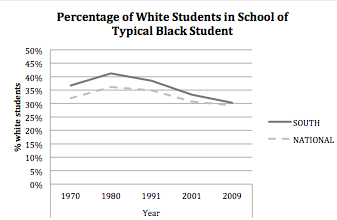In North Carolina, school resegregation by charter?

North Carolina could soon see a dramatic increase in the number of charter schools, with as many as 150 of the public-private hybrids opening across the state next year.
But new research from Duke University suggests the charter school boom will result in greater racial imbalance in the state's public education system -- and that can have negative educational consequences for students.
North Carolina limited the number of charter schools that could operate in the state to 100 until 2011. That's when the General Assembly -- with Republicans controlling both the House and Senate for the first time since Reconstruction and embracing a school-choice agenda -- lifted the cap.
Charter schools are K-12 schools that are publicly funded but privately run, are exempt from some regulations that traditional public institutions must follow, and are attended by choice rather than by assignment. Though operated as nonprofits, some are managed by for-profit corporations.
Since North Carolina lifted its cap, applications for new charter schools have soared, with one charter advocate recently telling The News & Observer of Raleigh, N.C. that the cap removal was "sort of like seeing a dam break."
Charter school advocates, whose ranks include President Obama as well as North Carolina Gov. Pat McCrory (R), tout them as bastions of educational innovation and excellence. But research raises questions about those claims.
An authoritative 2009 study by Stanford University researchers found that 37 percent of charter school students showed poorer academic gains than their counterparts in traditional public schools. Only 17 percent of charter school students experienced academic gains that were significantly better than their traditional public school students, while 46 percent showed no difference.
That study, which looked at charters in 16 states including North Carolina, also found that the learning gains of African-American and Latino charter school students were significantly worse than their counterparts in traditional public schools.
Students with disabilities have also experienced problems in charter schools. In New Orleans -- the only place in the country where a majority of students attend charter schools as a result of policy changes made in the wake of Hurricane Katrina -- some charters have failed to adequately serve special-needs students, which sparked the filing of a federal lawsuit against the school system.
Now new research suggests another problem with charters: They increase racial isolation, which can harm educational quality.
Last week, researchers at Duke University in Durham, N.C. released an update of their earlier study on racial and economic disparities in the state's public school system. They found that the racial balance in North Carolina's public schools has remained steady over the past seven years, ending the previous decade's trend of growing racial disparity.
However, they also found that charter schools are much more likely than traditional public schools to be racially unbalanced. According to a an announcement about the study from Duke's Sanford School of Public Policy:
Whereas 30 percent of regular public school students attended a racially unbalanced school (one with less than 20 percent or more than 80 percent minority enrollment), more than 60 percent of charter school students attended a racially unbalanced school.
Mecklenburg County, N.C., whose single public school system has the highest number of students enrolled in charter schools of any county the state, is also among the counties with the greatest racial imbalance in their schools, according to the Duke researchers.
The Duke study also found that students in North Carolina schools -- both charters and traditional public institutions -- are increasingly separated by family income. Looking at the percentage of students eligible for free lunch in schools within each of the state's 100 counties, the researchers discovered that imbalance by economic status has increased steadily since 1994-95.
"These disparities are important because research shows they can have negative educational consequences for students,” said Helen Ladd, a Sanford School professor and one of the study's authors.
Schools serving a disproportionately African-American, Latino or low-income student body tend to have teachers with weaker credentials in terms of teaching experience, degrees from competitive colleges, and regular teaching licenses or National Board Certification, the Duke researchers note. In addition, students who attend racially isolated schools miss out on opportunities to interact and learn from with students from different backgrounds.
Charles Clodfelter, a co-author of the Duke study, called the disparities "among the most pressing civil rights issues of our time."
What's happening in North Carolina is taking place in a national context of growing school segregation. A study released last year by the Civil Rights Project at UCLA found that while residential segregation was declining nationwide, school segregation for black students remains very high across the United States.
That research also found that segregation is increasing most dramatically in the South, which in the past has led the nation in school desegregation efforts. The changes now underway in North Carolina's public schools suggest that -- without a concerted effort toward integration -- that trend won't be reversing any time soon.
Tags
Sue Sturgis
Sue is the former editorial director of Facing South and the Institute for Southern Studies.
